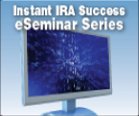IRAs are not savings accounts. The IRA account comes with some very strict rules on moving the funds from one account to another. If you do not follow the rules, you can lose the tax deferred status of the IRA funds and have to pay income tax on them.
There are two ways to move IRA or Roth IRA funds. You can do a trustee-to-trustee transfer (direct transfer) where the funds go directly from one IRA custodian to another, and you cannot spend the funds while they are out of the IRA. You can do an unlimited number of transfers. The other method is a rollover where the funds are distributed payable to you and you can spend them while they are out of the IRA. You have 60 days from the date you receive the funds to put them back into another IRA or qualified employer plan. You can only do ONE rollover per year (365 days) per IRA or Roth IRA account. If you take a second distribution before the year is up, it is a taxable distribution to you and the funds cannot be put back into an IRA.
There are some exceptions to this rule. Funds moved from an employer plan to an IRA, funds converted to a Roth IRA, funds moved from an IRA to an employer plan are all exceptions to the rule because they are not IRA to IRA rollovers. Other exceptions include qualified hurricane distributions, qualified reservist distributions, Exxon Valdez settlements that are rolled over, involuntary distributions from Resolution Trust Company, and first time home buyer distributions where the home purchase transaction is cancelled.
Be careful of these traps: looking for a higher earnings rate and moving the funds more frequently than once per year, taking advantage of the free look period to cancel an annuity when investing the IRA in an annuity, cashing out an investment or an IRA when you think the institution is in trouble, etc.
--By IRA Technical Consultant Beverly DeVeny and Jared Trexler
------------------------------------------------------------
Comment, Question, Discussion Topic on your mind? Click on the Blue Comment Link below and leave your thoughts then check back to see what other consumers and advisors think.
*Copyright 2009 Ed Slott and Company, LLC
Quality content
- Siti Non Aams
- Nuovi Siti Casino
- Casino Non Aams Italia
- Casinos Not On Gamstop
- Casino Sites Not On Gamstop
- Online Casino
- UK Casino Not On Gamstop
- Sites Not On Gamstop
- Casino En Ligne
- Casino En Ligne Fiable
- Casinos Not On Gamstop
- UK Casino Not On Gamstop
- Casino Sites Not On Gamstop
- Non Gamstop Casinos UK
- Casino Online Non Aams
- Casino Not On Gamstop
- Meilleur Casino En Ligne France
- Casino Sites Not On Gamstop
- Non Gamstop Casino Sites UK
- Casino Sites UK Not On Gamstop
- UK Casino Not On Gamstop
- Meilleur Casino En Ligne Fiable
- Casino Online Non Aams
- Casino Non Aams
- Casino Sites Not On Gamstop
- Meilleur Casino En Ligne Belgique
- Lista Casino Online Non Aams
- 안전한 파워볼사이트
- Meilleur Casino En Ligne 2026





1 comments:
We didn't know about this rule. I've made several rollovers, and no one has 'caught' us. anyone know how or who would check?
Post a Comment